For those of you who are thinking of getting a cell phone, there is so much
information, (and misinformation), out there, that we at the Gadgeteer thought it was time
to do a cell phone review. Although this review will focus on the Nokia 252 cell
phone, there is so much more information that you need to make an informed decision
regarding the purchase of a cell phone. Once we sift through all the information, I’ll
talk about the Nokia 252 phone’s advantages and disadvantages. (If you wish to jump
straight to the review, click here.)
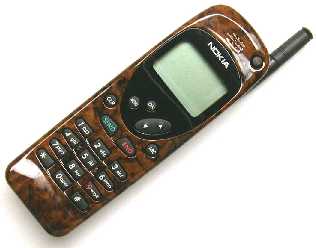
First of all, many people go out and buy a cell phone without understanding “the
big picture”. Of course the phone itself is very important. But how will you charge
it? How long will the batteries last? How long does it take to re-charge the batteries?
What about when I’m in my car? Should I get a booster kit? Should I get a car adapter? How
long is the warranty? What if I drop my phone and break it? Is it costly to repair? What
about a leather case? What about a flip phone? What about the calling packages? Should I
get digital or analog? Why do they call it “roaming”? (I’m starting to sound
like Roseanne Rosannadana here!)

“…Gee Mr. Damiani, you sure ask a lot of dumb
questions!”
I don’t have all of the answers for you. That’s because some can only be answered by
the person who will actually use the phone. But I have had many cell phones and I have
learned a lot in the process. The first thing you should do if you are thinking of buying
a cell phone is look at your budget. There are, as I mentioned above, many hidden costs
involved. The next thing you need to do is look at what your calling habits are, and/or,
what they will be, and what you need the phone for. This will be helpful in making the
decision on what calling plan to chose.
Regarding the budget, when you buy a cell phone, look at the calling plans that are
offered, and review the signal carrier’s calling area map. In the area that I live, (the
Midwest), some plans are very cheap, like 200 minutes per month for $20/month. But when I
looked at the calling area map, I found that the zone where the 200 minutes are used was
very small. Outside of that zone, there is a “roaming” charge for every minute.
I was charged as much as $4 per minute while out of my zone on a trip to the East Coast.
But I expected that and planned for it. You also get charged for long distance as well.
(Make these calls only if necessary!)
While in your zone, any calls that go over your monthly minutes are charged for at
different rates. My plan covers almost the entire state I live in, and charges 26 cents
per minute if I go over my monthly limit of 100 minutes. You really need to do research on
calling areas, and minutes offered as they relate to your calling needs. Someone who does
a lot out-of-state travel, may find a plan that is better for them than a local calling
plan. Also, some plans offer different rates for weekend calls than during the week. My
carrier has a plan that is $10 per month for unlimited calls on the weekend. If you need
to call someone in your calling zone on weekends, but it is otherwise a long distance
call, this kind of plan might be better than using your regular phone. A friend uses this
plan to call his relatives on his cell phone each week on the weekend and they talk for an
hour to each relative.

From “Today¹s Cartoon by Randy
Glasbergen”, posted with special
permission. For reprint information and many more cartoons, please visit
Randy’s site @ www.glasbergen.com or e-mail: ra***@********en.com
Keep in mind that you get charged for all of your cell phone time to the next highest
minute. This means that a 10 second call is charged at 1 minute. Also keep in mind that
you get charged for a call whether you make the call, or if someone calls you. I use the
formula that since I have 100 minutes, I can make around 3 minutes of calls each day. But
I also have the phone for emergencies. I am willing to pay whatever it costs per minute if
I am stuck on the road with my small kids in the car, or if I am in a car accident, (both
of which have happened).
If all of this is too confusing for you, take a look at the new flat-rate plans that
are being offered. You basically get a large number of monthly minutes, say 600 or 1000,
and you pay a flat-rate, $100-$150 per month. These plans are starting to create interest
because the minutes can be used anytime, and anywhere. (No long distance charges and no
more roaming charges!) The idea is to use the cell phone to replace
your conventional telephone. If you usually have a large telephone bill, this might be the
way to go.
But there are a few negatives to flat-rate plans. First, they all require digital
phones. Yes, digital phones are clearer than analog, but to date, the digital calling
zones are not as widespread as analog. Therefore you tend to get disconnected a lot. Of
course you still pay for the incoming calls as well as outgoing calls. And like
conventional cell phone calling plans, you pay for any unused minutes. (This could be a
problem if you miscalculate the number of minutes you think you will need by a large
margin.) But don’t be surprised if you see a major movement of consumers turning off their
telephones and replacing them with wireless during the next 3-5 years.
*For calling plan information in your area, check out www.wirelessdimension.com.
As you can see, we have covered a lot and still haven’t gotten to the review of the
phone. But wait, there’s more… Before I get to the phone
review, I want to talk a little about options and accessories. It’s important to know what
you are paying for when you buy your phone. A few years ago, I found 2 phones that were
identical in every way, except that one phone had a silent ring function, (you could set
it to vibrate). It was $25 extra for this function. But at closer examination, there were
more differences, that were not related to the phone itself.
I didn’t need a phone that vibrated. Phone A didn’t vibrate. Phone B did vibrate, and
was $25 more expensive. But Phone A had an older style NiCad battery. Phone B had a Nickel
Metal Hydride (NiMH) battery, which is better for charging when not fully drained. It also
lasted longer on a charge. Both phones had chargers for the batteries included, but Phone
B had a charger that could charge the battery fully in 2 hours. Phone A’s charger took 8
hours. Phone A had a 1 year warranty, but Phone B had a 3 year warranty. I finally
bought Phone B. When researching your cell phone, ask about warranty, chargers, battery
type, and hours of charging time.
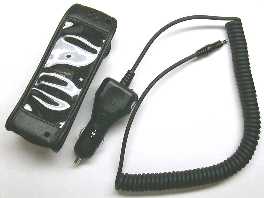
When it comes to options, it all depends on what you find useful. When it comes to
accessories, I like to go with only 2: a leather case for protection, and a car
adapter.(As shown above.) But it’s important to shop around for them also. I recently
bought 2 cell phones for my “other” business. So all of the costs were doubled.
I found the phone I liked, the Nokia 252, and the case and car adapter. But all of the
prices were different in the 3 different places I went to. Here’s a short breakdown;
| Major cellular provider: Phone: $69.99 Case: $24.99 Car adapter: $29.99 |
Radio Shack: Phone: $19.99 Case: $29.99 Car adapter: $34.99 |
Local cellular provider: Phone: $49.99 Case: $9.99 Car adapter: $24.99 |
All of the providers listed above used the same calling plans, so I bought the phones
from Radio Shack, and the 2 accessories from the local small business cellular provider.
Using this example, I could have spent $269.94 for both phones (worse case). Instead, it
cost me $109.94 for both phones. As Smokey Robinson says, “You better shop
around!”
And now, about the Nokia 252 cell phone. This
is one of the nicer phones that I have owned. It is a smaller analog phone,
measuring approximately 5.5 inches long, (not including the antenna), and 2 inches wide.
It is light weight, (6.2 oz), and fits into a pocket or purse easily. (By the way,
if you are someone who reads Consumer Reports before you buy, this phone was one of the
top rated cell phones.)
 |
 |
 |
 |
 |
 |
 |
 |
 |
 |
| Antique Bronze | Brushed Aluminum | Blue Glass | Hunter Green | Midnight Black | Pewter | Royal Blue | Signal Glow | Turbo Red | Wood Grain |
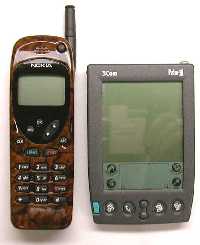 |
The Nokia 252 comes in many colors, as shown above. But depending on where you buy it, you will be restricted to what colors they have. My local Radio Shack had only Wood Grain, Black, and Pewter to choose from. But most providers can get the color you want if you ask, it just may take longer to get it. If you are someone who likes change, there are other colored faceplates that you can buy separately, like purple, and you can easily switch them. (Sorry, no camouflage!)The actual size and weight of the cellular phone is also something that you might want to consider before you purchase your phone. The Nokia 252 is a nice compact phone. It easily fits in your pocket or purse. It is also quite lightweight. To the left you will see a picture of how it compares in size to a Palm III PDA. |
| “Talk time” and “standby time” refer to the amount of time you can use the phone while talking to someone, and the amount of time the phone will operate while you are not talking and are on standby. With the standard NiMH battery, the Nokia 252 has 2 hrs 45 min of talk time and 40 hours of standby time. The battery charger that is standard with the unit is a 6-8 hour charger. If you want the Rapid Travel Charger (ACP-9U) it costs extra.Some of the options that the Nokia 252 phone has are: one-touch dialing, a “Phone Book” data base that stores up to 75 names and numbers, on-screen notification of roaming status, ability to use voice mail and caller ID(where available), a backlit screen, silent or vibrate, and 6 different ring tunes. Speaking of the ring tunes, they range from a standard phone ring, to classical music,(I believe it’s Mozart). Just paging through them at work raised many an eyebrow! |
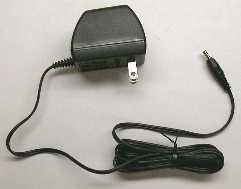 |
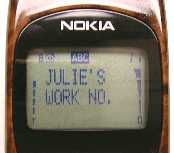 |
Names and numbers can be easily entered into the Phone Book via the on screen menu. But be careful how you enter them. I used the instructions in the owners manual, and was unable to get it to work properly. When I took the phone back to where I bought it, I was told that Nokia changed this functionality a bit and the owners manuals may not have been updated. After you have some phone numbers and names in your phone book, you can scroll through the listing of names or listing of numbers to find someone you wish to call. Then you just push the “send” button and it places the call. If someone calls you, simply touch any button except the “Power” or “End” buttons to answer the call. |
| The antenna on the Nokia 252 is a bit wimpy as compared to the rest of the phone. It seems that lots of cell phones have wimpy antennas. To be honest, although the owners manual states that you should extend the antenna while talking on the phone, I often wonder if it makes a difference. The owners manual says that not extending the antenna causes the phone to operate at a higher power. (But I’ve heard that some cell phones, made by a large company that begins with a “M”, have an extendable antenna placebo. It’s there because the consumer wants a phone to have it. I’ve not verified this rumor, so please, no hate mail.)As I have said earlier, I like to have my phone in a protective case, for the same reason that I would have my PalmPilot in a case. But keep in mind that you get your phone pretty cheap when you sign up for a cellular service package, but if you want to buy this phone without the package, it can cost $150 or more. It’s not as if it would cost $19.99 to replace it if it was broken. Most service providers offer insurance on the phone, for $3-$6 per month extra. But I recommend a rider on your home owners insurance. I have my phone insured on my home owners policy for $6 per year. By the way, the case that I bought makes it a bit harder to push the Power button, but I like it anyway. Another very important thing that one should take into consideration in the purchase of |
 |
There are as many different styles of phone out there as there are tastes in phones.
You need to decide which phone is best for you. But hopefully this review will give you a
little more knowledge about the entire process of owning a cell phone, so you can be a
more informed consumer.
Price: Depends on service provider.
Pros:
Small and lightweight.
75 name/number Phone Book
Comes in many colors.
Signal holding capability highly rated.
Cons:
Power button hard to push while in leather case.
Would prefer a faster battery charger.
Antenna is wimpy compared to the rest of the phone.
Nokia CP-532 Black
$28.08 (as of July 2, 2025 22:25 GMT -04:00 - More infoProduct prices and availability are accurate as of the date/time indicated and are subject to change. Any price and availability information displayed on [relevant Amazon Site(s), as applicable] at the time of purchase will apply to the purchase of this product.)Nokia T20 TA-1392 64GB Wi-Fi Android Tablet - Ocean Blue
Product Information
| Price: | |
| Manufacturer: | Nokia |



Gadgeteer Comment Policy - Please read before commenting
My screen also started going dim in the same fashion, it was a Palm Vx. The battery life was always fine, but the screen kept on getting dimmer and dimmer until I eventually had to toss the unit because I couldn’t read it even by squinting anymore.
When it started happening I did a lot of research and found a lot of different people complaining about another screen problem, the infamous digitizer misalignment. I found dozens of message board threads just dedicated to this problem as well as four separate programs to work around it by resetting the digitizer on every bootup, I thought it was a weird issue…nobody had a good solution or an explanation of what was happening, so I emailed Palm about the digitizer issue just to see what the official story was, and they literally told me they’d never heard of the issue! Check it out:
<quote> Palm, Inc. is unaware if any such issues with the screen not responding
well specifically as regards the Palm Vx handheld.
The issue that you are experiencing might be due to the presence of
certain third-party applications or due to corrupt databases on the Palm
handheld. The presence of third-party software or corrupt databases on
the Palm handheld usually causes an issue with the working of the Palm OS.</quote>
I was like, what the $#@#$#@, this is a problem that is widely reported with numerous hackish workarounds and Palm technical support is pretending they’ve never heard of it? This is clearly either drastically incompetent or (I assumed) tremendously dishonest!! I figure anyone with that kind of attitude isn’t going to correct their problems, they’ll just keep lying about them.
So, I figure that’s what happened with the screen fade, rather than fixing the trouble they just lie about it and pretend they’ve never heard about it and try to gouge you on service fees. I bet if they did an honest accounting we’d find that the number of palms with this specific display problem is huge, and they make people go through the gymnastics just to try to reduce the warranty services for the hardware fault.
It’s a real pity though, PalmOS beat out WinCE in my book any day, and there’s no sexier palm than the Tungsten. *sigh*
I really love this website btw – THANKS!
– Greg
And yet another reason why the Sony Clies are superior to the Palms. Have yet to hear from NX owners on any problems. Plus we now have CF Card support!
contempt,
Sony may have better quality control than Palm (and even that is subjective , as I have had more than one CLIE come with dust under the screen – from the factory), but Sony’s customer service is definitely not going to win any awards with me. They have yet to redeem themselves with me for the CLIE 710C which would not work with XP (unles you paid $50 for the upgrade).
…and another thing: the only reason CLIEs with “wireless” slots even have the ability to support CF cards is because of wonderful developers out there that are not affiliated with Sony. If it were up to Sony, you would never have had that option.
That is not to say that the CLIE is not a great PDA…it is. But Sony, the company, is certainly not blameless or superior to Palm.
<stepping now soapbox my off>
Judie :0)
I buy one of these Nokia 252 phones. I pay R$35 with ship (something like U$15 to U$17).
But is not to use, just for my cell phone collection.
The cellphone screen first lit white but i could call and receive and other programes were also responding when not using the screen.It now stopped lighting the screen also and does not start when the start button is pressed.I am thank full for any information on how to over come this.
When i switch on my cellphone it switches it self off before the screen even lights up.The problem started with the screen lighting only white and not displaying any thing but responding to all programes when using the button face.I will be glade with any solution you send me.